Lise Tréhot
Lise Tréhot (14 March 1848 – 12 March 1922) was a French art model who posed for artist Pierre-Auguste Renoir from 1866 until 1872, during his early Salon period. She appeared in more than twenty paintings, including notable works such as Lise (1867) and In Summer (1868), and she was the model for almost all of Renoir's work featuring female figures at this time. Tréhot married Georges Brière de l'Isle in 1883 and raised four children to whom she bequeathed two of Renoir's paintings, Lise Sewing (1867–68) and Lise With a White Shawl (1872), both of which are currently held by the Dallas Museum of Art.[1][2]
Lise Tréhot | |
|---|---|
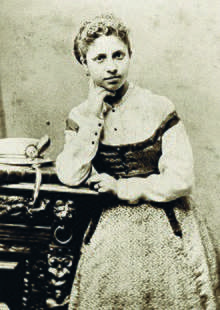 Lise in 1864 | |
| Born | 14 March 1848 Ecquevilly, Seine-et-Oise, France |
| Died | 12 March 1922 (aged 73) Paris, France |
| Nationality | French |
| Occupation | Art model, dressmaker |
| Years active | 1866–1872 |
| Known for | Modeling for Pierre-Auguste Renoir |
Early life
Lise Tréhot was born in Ecquevilly, Seine-et-Oise, France, on 14 March 1848, to Louis Tréhot and Amelie Elisabeth Boudin. Her father was the postmaster of the town until the mid-1850s, after which he moved the entire family to Paris where he sold lemonade and tobacco. She was the fourth in a family of six children, including three brothers and two sisters. A document from this time describes Tréhot's profession as a dressmaker. Clémence Tréhot, her older sister, was the lover of artist Jules Le Coeur, who later introduced her to Pierre-Auguste Renoir at his house in Marlotte, possibly in June 1865.[2][3][4][5]
Modeling period
Tréhot began modeling for Renoir when she was about eighteen and he was twenty-five. Early paintings of Tréhot at this time include Lise in a Straw Hat (1866) and Lise Sewing (1867–68). Renoir painted a modern nude of Tréhot as Diana (1867), but it was rejected by the Salon of 1867. Renoir found critical success the next year with Lise (1867), which was well received at the Salon of 1868. The Impressionist painting depicts Tréhot in a life-size portrait, strolling through a wooded park as sunlight falls through the trees.[5] Art critic Zacharie Astruc described Tréhot in Lise as "the likeable Parisian girl in the woods", and as a working-class girl.[5] Émile Zola also approved, comparing Tréhot to Monet's model and later wife Camille Doncieux.[1][6] French art critic Théodore Duret later observed that because Renoir's Lise was derivative of Gustave Courbet's technique, its appearance at the Salon "provoked no definite opposition".[7] However, Renoir's decision to shadow Tréhot's face in darkness and emphasize the reflection of sunlight from her white dress in Lise led several critics to ridicule Tréhot's appearance due to the unusual contrast.[4][8][9]
At the Salon of 1869, Tréhot appeared in a work named In Summer (1868), dressed casually in a loose blouse falling off her shoulders. John Collins notes that Tréhot's "dark, heavy-set and expressionless features" worked well in such portraits, but were less successful in more formal, costume-oriented paintings such as The Engaged Couple (1868), where she poses with artist Alfred Sisley. In the summer of 1869, she accompanied Renoir to his parents’ house in the Ville-d'Avray, and made trips to the Seine near Bougival where Renoir painted scenes with Monet on the water. La Barque (1870) is thought to depict Lise during this summer holiday.[2]
In total, Tréhot appeared in more than twenty paintings by Renoir during his early Salon period from approximately 1866 until 1872.[1][5] According to art historian John House, "Lise was the model for virtually all of Renoir's female figures at this time".[10]
Although little is known about the exact nature of Tréhot's relationship with Renoir while she was modeling; she is said to have given birth to a baby boy named Pierre on 14 December 1868, but it is unclear what became of him and he may have died as an infant. On 21 July 1870, Tréhot gave birth to a baby girl named Jeanne (d. 1934) who was given to a wet nurse to raise as her own. Renoir continued to secretly support Jeanne financially until he died (and after his death with the help of Ambroise Vollard), but never publicly or legally acknowledged that she was his daughter during his lifetime.[5][11][12]
For unknown reasons, Tréhot stopped modeling for Renoir after 1872; it was said that she never spoke to or saw him again. Although Tréhot was an important part of Renoir's early career, he never mentioned her in any published interviews, memoirs, or biographies.[1][5]
Later life
In 1883, more than a decade after Tréhot stopped modeling for Renoir, she married architect Georges Brière de l'Isle (1847–1902). As the wife of Brière de l'Isle, she raised two sons and two daughters.[5] Tréhot bequeathed two of Renoir's paintings, Lise Sewing (1867–68) and Lise With a White Shawl (1872), to her children. It is said that before her death, she destroyed many of her personal papers related to her time modeling for Renoir. Tréhot died in Paris on 12 March 1922, at the age of 73. She is buried in the Père Lachaise Cemetery.[2]
Selected works as model
Tréhot's list of selected works includes at least twenty-five oil on canvas paintings, twenty-three of which were painted by Renoir, while two are by Frédéric Bazille (1841–1870). It is thought that Tréhot may have posed for as many as twenty-three works for Renoir,[1] but only once for Bazille; Renoir's Landscape with Two People (1866), in which she appeared, has either been lost or destroyed, but is believed to have been preserved as a painting within a painting in Bazille's Studio (1870). Bazille's work is the only known surviving image of the full painting; a surviving fragment of the work has been identified, but its location is unknown. Tréhot is believed to have posed for La Toilette (1869–70), another work by Bazille.[5][8]
| Year | Image | Title | Type | Dimensions | Gallery | Notes |
|---|---|---|---|---|---|---|
| 1866 |  |
Lise in a Straw Hat (Jeune fille au chapeau de paille) |
Oil on canvas | 47 × 38.4 cm | Barnes Foundation | [5][13] |
| 1866 |  |
Standing Young Woman | Oil on canvas | 24.5 × 14 cm | Private collection | [14] |
| 1866 |  |
Young Woman Seated in the Countryside | Oil on canvas | 24.5 × 14 cm | Private collection | [14] |
| 1866 |  |
Woman Standing by a Tree | Oil on canvas | 25.2 × 15.9 cm | National Gallery of Art | [15] |
| 1866 |  |
Woman by a Fence | Oil on canvas | 25 × 16.1 cm | National Gallery of Art | [15] |
| 1866 |  |
Woman in a Park | Oil on canvas | 26.1 × 16.1 cm | National Gallery of Art | [15] |
| 1866 |  |
Landscape with Two People (Paysage avec deux personnages) | Oil on canvas | Unknown | Only a fragment of the painting survives, depicting just the seated woman with the title of La Dame a l'oiseau. Its location is unknown. The image here is a closeup of Renoir's painting displayed within Bazille's painting, Bazille's Studio (1870). | [5][16] |
| 1867–68 | 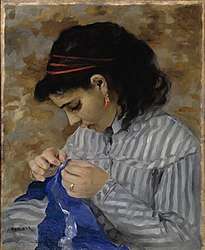 |
Lise Sewing | Oil on canvas | 55.9 × 45.7 cm | Dallas Museum of Art | [5] |
| 1867 | 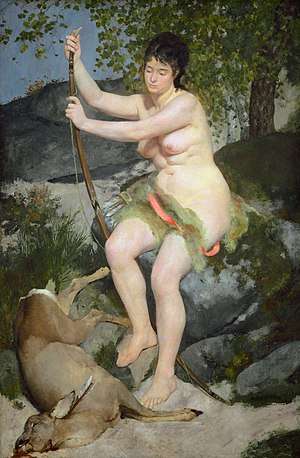 |
Diana | Oil on canvas | 197 × 132 cm | National Gallery of Art | [15] |
| 1867 | _-_Pierre-Auguste_Renoir.jpg) |
Portrait of Lise (Lise holding a bouquet of wild flowers) | Oil on canvas | 65.2 × 50.3 cm | Private collection | [1] |
| 1867 | 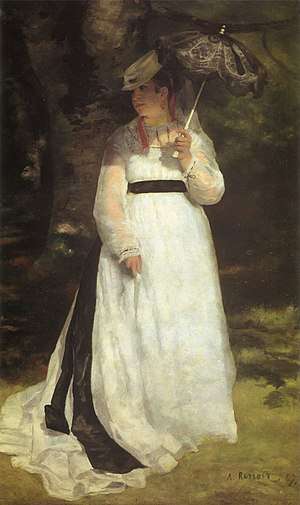 |
Lise (Lise With Umbrella) | Oil on canvas | 184 × 115 cm | Museum Folkwang | [5] |
| 1868 |  |
Woman in a Garden | Oil on canvas | 105.5 × 73.4 cm | Kunstmuseum Basel | [17] |
| 1868 | 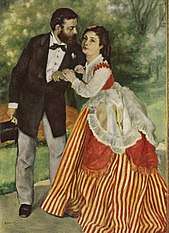 |
The Engaged Couple | Oil on canvas | 105 × 75 cm | Wallraf-Richartz Museum | [5] |
| 1868 |  |
In Summer: Study | Oil on canvas | 85 × 59 cm | Alte Nationalgalerie | [5] |
| 1869–70 | 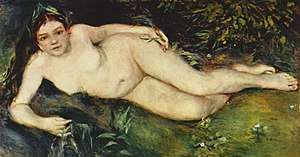 |
A Nymph by a Stream | Oil on canvas | 66.5 × 124 cm | National Gallery, London | [15] |
| 1869–70 | 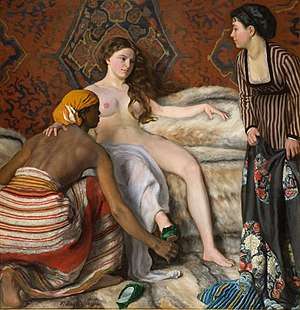 |
La Toilette | Oil on canvas | 132 × 127 cm | Musée Fabre | [8] |
| 1870 | 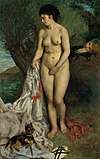 |
Bather with a Griffon | Oil on canvas | 184 × 115 cm | São Paulo Museum of Art | [5] |
| 1870 |  |
Woman of Algiers (Odalisque) | Oil on canvas | 69.2 × 122.6 cm | National Gallery of Art | [15] |
| 1870 |  |
Jeune femme dans une barque (La Barque) | Oil on canvas | 29.5 × 33.2 cm | Private collection | [18] |
| 1870 |  |
La Promenade | Oil on canvas | 81.3 × 65 cm | Getty Center | [10] |
| 1871 | 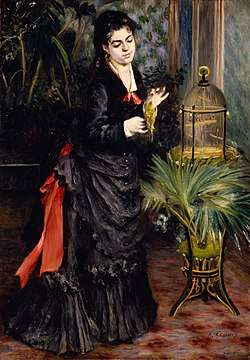 |
Woman with Parrot | Oil on canvas | 92.1 × 65.1 cm | Solomon R. Guggenheim Museum | [1] |
| 1871–72 | 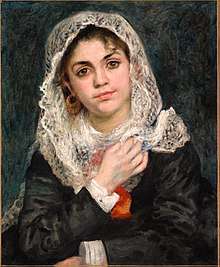 |
Lise in a White Shawl | Oil on canvas | 56 × 46 cm | Dallas Museum of Art | [5] |
| 1871–72 |  |
Femme demi-nue couchée (Reclining Nude) | Oil on canvas | 29.5 × 25 cm | Musée d'Orsay | [19] |
| 1872 | .jpg) |
Woman with Parasol Seated in the Garden | Oil on canvas | 46 × 37.9 cm | Private collection | [6] |
| 1872 | 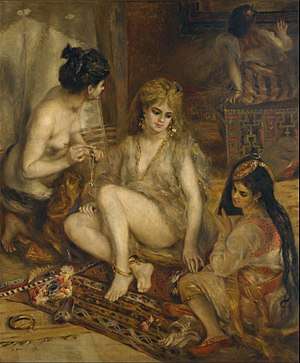 |
Parisian Women in Algerian Costume (The Harem) | Oil on canvas | 156 cm × 129 cm | National Museum of Western Art | [15] |
References
- Collins, John (2013). "Tréhot, Lise." In Jill Berk Jiminez (ed). Dictionary of Artists' Models. Routeledge. pp.526–528. ISBN 9781135959210. OCLC 46944625.
- Cooper, Douglas (May 1959). "Renoir, Lise and the Le Cœur Family: A Study of Renoir's Early Development-1 Lise." The Burlington Magazine, 101 (674): 162–171. OCLC 53397979. (subscription required)
- Cooper, Douglas (Sept–Oct 1959). "Renoir, Lise and the Le Cœur Family: A Study of Renoir's Early Development-II: The Le Cœurs." The Burlington Magazine, 101 (678/679): 320, 322–329. OCLC 53397979. (subscription required)
- Distel, Anne (1995). Renoir: A Sensuous Vision. "Abrams Discoveries" series. New York: Harry N. Abrams. p. 25. ISBN 9780810928756. OCLC 34704757.
- House, John. (2013). "The Many Faces of Lise Tréhot: Pierre-Auguste Renoir's Portraits of Parisiennes." In Heather MacDonald (ed.) Impressionism and Post-Impressionism at the Dallas Museum of Art. The Richard R. Brettell Lecture Series. Yale University Press. pp. 25–36. ISBN 978-0-300-18757-1. OCLC 844731572.
- Strieter, Terry W. (1999). Nineteenth-century European Art: A Topical Dictionary. Greenwood Press. pp.247–248. ISBN 978-0-313-29898-1. OCLC 185705650.
- Duret, Théodore (1910). Manet and the French Impressionists. G. Richards. p. 111. OCLC 744658.
- Tinterow, Gary. Henri Loyrette (1994). Origins of Impressionism. Metropolitan Museum of Art. p. 140-142, 337. ISBN 9780870997174. OCLC 30623473.
- White, Barbara Ehrlich (2010). Renoir: His Life, Art, and Letters. Abrams. p. 28. ISBN 9780810996076. OCLC 503442731.
- House, John (1997). Pierre-Auguste Renoir: La Promenade. Getty Publications. pp. 14, 81. ISBN 9780892363650. OCLC 37109128.
- Distel, Anne (2010). Renoir. Abbeville Press. pp. 70–74. ISBN 978-0789210579. OCLC 435419243.
- Rainbow, Rebecca (ed). (2006). Cézanne to Picasso: Ambroise Vollard, Patron of the Avant-Garde. Metropolitan Museum of Art. pp. 146, 149. ISBN 978-1588391957. OCLC 185422996.
- Lucy, Martha. John House (2012). Renoir in the Barnes Foundation. Yale University Press. pp. 68–69. ISBN 9780300151008. OCLC 742017633.
- As cited on Christie's website: Dauberville, G.-P. Michel Dauberville (2007). Renoir: Catalogue Raisonné des Tableaux, Pastels, Dessins et Aquarelles. Volume I. p. 390. ISBN 9782916873008. OCLC 297153894.
- Coman, Florence E. (2004). Impressionism, An Intimate View: Small French Paintings in the National Gallery of Art. National Gallery of Art. p. 30. ISBN 978-1904832034. OCLC 55016362.
- Le Cœur, Marc (May 1998). "A Drawing of Renoir in 1866". The Burlington Magazine, 140 (1142): 320-322.
- Bott, Gian Casper (2004). Kunstmuseum Basel. Foundation BNP Paribas Switzerland in cooperation with the Swiss Institute for Art Research. p. 41. ISBN 9783908196303. OCLC 609181786.
- As cited in Cooper (May 1959): Vollard, A. (1918). Pierre-Auguste Renoir, Tableaux, pastels et dessins. Volume I, no. 19, p. 5. "La Barque".
- Laclotte, Michel (1987). The Musee d'Orsay, Paris. H.N. Abrams, p. 87. ISBN 9780810914469. OCLC 15489594.
Further reading
- Marc Le Cœur, "O pintor, o primeiro modelo e seus primeiros admiradores: A historía que Renoir não mencionava" [Le peintre, son premier modèle et ses premiers amateurs: l'histoire dont Renoir ne voulait pas parler], Renoir: O Pintor da Vida, São Paulo, MASP, 2002, p. 33–65 (in Portuguese), 196–223 (in French) et 255–279 (in English)
- Gélineau, Jean-Claude (2007). Jeanne Tréhot: La fille cachée de Pierre Auguste Renoir. Essoyes. ISBN 9782865500307. OCLC 181092138.
- Marc Le Cœur, Renoir au temps de la bohème. L'histoire que l'artiste voulait oublier, Paris, L’Échoppe, 2009. ISBN 978-2-84068-220-2. OCLC 451095813.
External links
![]()